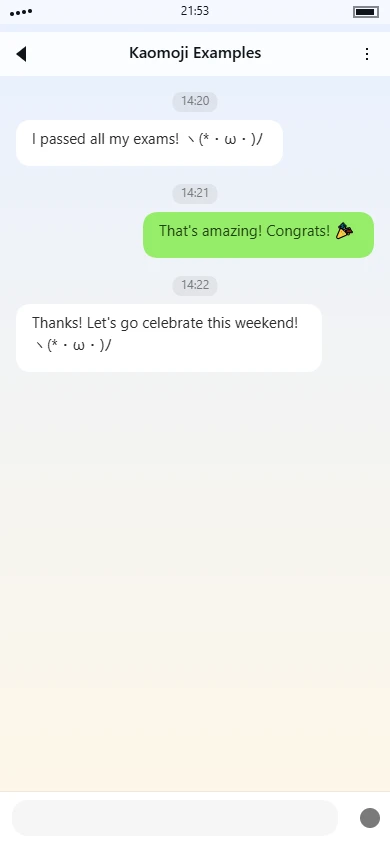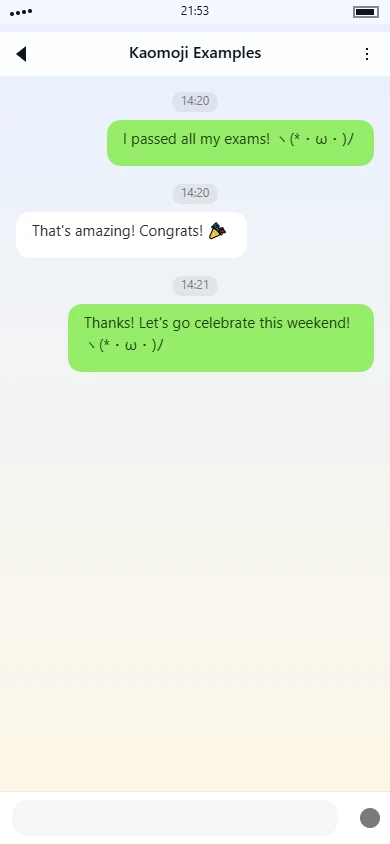(^人^) kaomoji meaning | usage tips

Overview
The kaomoji (^人^) presents a straightforward representation of a smiling face with a cheerful expression. Its symmetrical structure creates a balanced visual appearance that conveys a sense of contentment and friendliness. This particular arrangement of characters forms what could be considered a basic template for positive facial expressions in text-based communication.
Symbol Breakdown
- Parentheses ( ): These curved brackets serve as the outer boundary of the face, creating a rounded contour that mimics the shape of a human head or face outline
- Caret symbols ^ ^: Positioned as eyes, these upward-pointing characters suggest raised eyebrows or smiling eyes, contributing to the overall happy expression
- 人 character: The Chinese/Japanese kanji for "person" or "human" occupies the center position, functioning as both the nose and mouth area while adding cultural specificity to the expression
- Spacing and alignment: The characters are positioned with minimal spacing between them, creating a compact facial structure that appears cohesive and intentionally arranged
Emotion & Aesthetic Analysis
The emotional tone conveyed by (^人^) is predominantly cheerful and content. The upward-pointing carets as eyes create an impression of raised eyebrows, which typically accompanies smiling or pleasantly surprised expressions in real human faces. The central 人 character adds a distinctive element that differentiates this kaomoji from Western-style emoticons that typically use punctuation marks for facial features.
Compared to similar kaomoji like (^_^) or (^^), the use of the 人 character provides a slightly more formal or culturally specific appearance while maintaining the same basic cheerful expression. The symmetry of the design contributes to a sense of balance and harmony in the expression, making it suitable for conveying general positivity without excessive excitement or intensity. This kaomoji occupies a middle ground between simple punctuation-based smiles and more elaborate character compositions, making it versatile for various casual digital communications where a friendly, approachable tone is desired.
Tag categories
Use tags to quickly understand this kaomoji.
Emotion tags
Click tags to explore related kaomoji.
Usage guide
Usage Guide for (^人^)
The kaomoji (^人^) is a charming and versatile emoticon that conveys a range of positive emotions through its simple yet expressive design. Featuring upward-curving eyes that suggest happiness and a small mouth that adds a touch of innocence, this emoticon is perfect for creating a warm, friendly tone in digital communication. It's commonly used to express gratitude, gentle happiness, polite agreement, or a sense of contentment in casual online conversations. The balanced facial expression makes it suitable for various contexts where you want to maintain a positive but not overly enthusiastic vibe.
Common Use Cases
- Expressing thanks when someone helps you with a small favor
- Showing polite agreement in a group chat discussion
- Responding to a friend's good news with gentle happiness
- Adding a friendly tone to work messages with close colleagues
- Reacting to cute pet photos or heartwarming stories
- Acknowledging someone's effort without being overly dramatic
- Creating a positive atmosphere in online gaming chats
- Softening requests to make them sound more polite
- Showing you're satisfied with a simple solution
- Responding to compliments with humble appreciation
- Expressing quiet contentment about everyday moments
- Wrapping up conversations on a positive note
Example Conversations
-
Friend chat
A: I picked up your favorite coffee on my way over B: Thanks! (^人^) You're the best!
-
Work collaboration
A: I've shared the document with editing access B: Got it, thanks! (^人^) I'll review it this afternoon
-
Social media comment
Post: Finally finished that big project! Comment: Congratulations! (^人^) Well deserved break time
-
Family group chat
A: Dinner's ready whenever you are B: On my way! (^人^) Smells amazing from here
-
Online community
A: Here's that tutorial you asked for B: Perfect! (^人^) This is exactly what I needed
-
Casual planning
A: How about we meet at 3pm instead? B: Sounds good to me (^人^) See you then!
Important Notes
- Avoid using this emoticon in formal business communications or serious discussions where a professional tone is required
- While generally positive, the subtle nature of this kaomoji might be misinterpreted as passive-aggressive in tense situations
- Consider your relationship with the recipient - it works best with friends, family, and colleagues you have a comfortable rapport with
This kaomoji works particularly well on platforms like Discord, casual work chats (Slack/Teams), and social media where the tone is more relaxed. Its balanced expression makes it a safe choice for maintaining positivity without coming across as too intense or childish.
Usage examples
Real conversation samples that feature this kaomoji.

Example 1

Example 2
Related kaomoji
You might also enjoy these kaomoji.